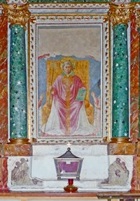


Frescoes (1450) of St Fortunatus by Benozzo Gozzoli
Altare di San Fortunato, San Fortunato, Montefalco
St Fortunatus (1st June)
An entry in the Roman Martyrology under 1st June reads: “At Montefalco in Umbria, St Fortunatus, a priest renowned for his virtues and his miracles”.
The earliest known copy of the legend of St Fortunatus (BHL 3087a) is contained in the Leggendari del Duomo. The legend was written by a man called Audelaus (who was probably a priest and whose name suggests that he was a Lombard), probably in the late 7th century. Audelaus writes that he had based his work on the verbal account of a venerable priest called Firmino.
According to this legend, St Fortunatus was “Turritane ecclesia presbiter” (priest of the church of Turrita, probably around Santa Maria di Turrita). He also worked as a farmer and was renowned for his charity to the poor. When he died (according to tradition in ca. 395) he was buried in a field in a place called “Agellus”. The rod that he had used to drive his oxen miraculously burst into leaf when it was stuck in the ground after his death. This became his defining iconographical attribute (as in the illustration above). The place of the burial is usually identified as the locality that was known until relatively recently as Agelli, in Camiano (see San Rocco).
Some 20 years later, St Severus (see below) stopped at the site of St Fortunatus’ grave while en route to Ravenna, where he faced trial. By this time, the relics seem to have been moved to the present site of San Fortunato. He promised to build a church on the spot if St Fortunatus would secure his acquittal, and survived to keep his promise. Bishop Spes of Spoleto consecrated the church that he built (according to tradition, on 8th August 422) after having translated the relics of St Fortunatus to its altar.
St Severus (1st February)

St Severus (17th century)
Altare di San Severo, San Fortunato, Montefalco
As noted above, St Severus has a prominent role in the legend of St Fortunatus. He has his own legend (BHL 7675d), in which he is described as “militiae gerens officium, civis Martanus”. This saint has the same feast day as St Severus of Ravenna.
The legend of St Fortunatus records that the soldier Severus, a citizen of “Martana” (see also the page on Saints of Massa Martana), discovered a hoard of treasure in a field. When he sent it to the emperor in Rome, he was rewarded with the post of “Magister Militum” (Master of the Soldiers), a senior military post that was introduced in the early 4th century. This promotion attracted the envy and enmity of a certain “Patricius” in Ravenna: this might have been a name or a title, perhaps that of Patrician, a senior civic post in the late Roman Empire.
St Severus was arrested and taken to Ravenna in chains. The party stopped at the site of St Fortunatus’ grave, which a multitude of Christians had gathered to pray. He promised St Fortunatus that, if he were acquitted, he would build a church on the spot before he returned to his home. St Fortunatus duly appeared in a dream to Patricius, threatening him with death unless St Severus were acquitted. Patricius was duly chastened and St Severus was allowed to return to his home. En route, he built the church that he had promised (later San Fortunato).
Relics of SS Fortunatus and Severus
St Fortunatus


St Severus

The damaged paintings in tondi of the Pietà and adoring angels against a background of fictive granite and porphyry are attributed to Benozzo Gozzoli. Although most of the original painting has been lost, the attribution is supported by the quality of the visible under-drawing.
Read more:
S. Nessi and E. Paoli, “San Fortunato di Montefalco: un Evangelizzatore Umbro del IV Secolo”, (1995) Assisi
Return to Saints of Montefalco.

